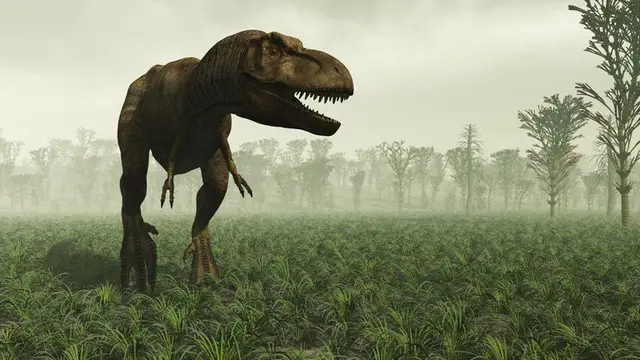The tyrannosaurus rex was able to bite through bone by keeping a joint in its lower jaw steady like an alligator, a new study suggests.
The anatomy of the carnivorous dinosaur has puzzled palaeontologists, but new research has shed some light on how it was able to crush animals' bones without breaking its own jaw.
Dinosaurs all had a joint in middle of their lower jaw called the intramandibular joint, which is also found in reptiles today.
Previous studies suggested that this joint was flexible - similar to that of snakes - which helped the meat eating dinosaurs trap their prey in its jaws.
However scientists often wondered whether the joint was flexible at all, or how they it was strong enough to bite through and ingest bone which fossil evidence shows the T rex did.
John Fortner, a doctoral student in anatomy at the University of Missouri and the lead author of the study, said: "We discovered that these joints likely were not flexible at all, as dinosaurs like T rex possess specialised bones that cross the joint to stiffen the lower jaw."
CT scans of dinosaur fossils and modern reptiles were used by researchers to create a detailed and accurate 3D model of the T rex jaw.
The simulations included bone, tendons and specialised muscles that wrapped around the back of the mandible, which studies undertaken previously did not.
Mr Fortner said: "We are modelling dinosaur jaws in a way that simply has not been done before.
"We are the first to generate a 3D model of a dinosaur mandible which incorporates not only an intramandibular joint, but also simulates the soft tissues within and around the jaw."
In order to determine whether the intramandibular joint could withstand flexibility under the force required to chomp through bone, the research team conducted a series of simulations to determine the strains that would occur at various points in the dinosaurs jaw.
The results from these simulations suggested that the prearticular, the bone running along the inside of the jaw, acted as a strain that counteracted bending at the intramandibular muscle and kept the lower jaw stiff.
Mr Fortner added: "Because dinosaur mandibles are actually built so much like living reptiles, we can use the anatomy of living reptiles to inform how we construct our mandible models.
"In turn, the discoveries we make about T rex's mandible can provide more clarity on the diversity of feeding function in today's reptiles, like crocodilians and birds."
The findings will be presented at the American Association for Anatomy annual meeting during the Experimental Biology 2021 meeting, which will be held virtually from April 27 to April 30.
 简体中文
简体中文





